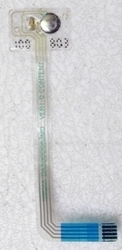Don’t Overlook The Obvious….
21 May
 Sometimes overlooking the obvious can result in a repair being much harder than it needs to be. A laptop came in with strange behavior. It would just shutdown randomly. Not a normal shutdown – a hard shutdown. The computer would just turn off. Sometimes in windows, sometimes during boot, heck sometimes during POST. No errors, no blue screen. Just OFF.
Sometimes overlooking the obvious can result in a repair being much harder than it needs to be. A laptop came in with strange behavior. It would just shutdown randomly. Not a normal shutdown – a hard shutdown. The computer would just turn off. Sometimes in windows, sometimes during boot, heck sometimes during POST. No errors, no blue screen. Just OFF.
Older systems had primitive overheating protection like this. CPU gets too hot, system turns off. Nowadays the systems will throw a BIOS alarm before shutting down and this was a newer laptop, so it made no sense. Heatsink was clean and the fan was working fine. The exhaust temp was reasonable.
The bizarre nature of when it shutdown pointed to hardware. So we swapped out the CPU. It ran well for a while, then suddenly started doing it again a few days later as we worked to update windows and such.
Then I saw it. Unlike most laptops that use an actual pushbutton switch, this laptop used a membrane assembly for it’s power switch. These are notorious for shorting out. Could it be that simple? Easy to figure out. Powered up the laptop then disconnected the button from the motherboard and ran HeavyLoad for a week.
Sure enough – the power button membrane was shorting out at random times. The weird thing is – you have to hold a power button down for 10 seconds to shut a system down. So this thing was randomly shortly out for extended periods of time while other times it was ‘open’ like it was supposed to be. Unless the BIOS was seeing repeated button closures due to the short and interpreting that as an extended hold.
Either way – looking back it seems so obvious. But given how laptop power buttons work with the extended hold to hard shutdown, it seemed very unlikely.
So if you’re troubleshooting a laptop, or any system for that matter, don’t overlook the obvious. Even if it seems highly unlikely. Testing this was trivial – all I had to do was pull that tiny cable with the laptop on and it would have saved me so much grief.




Leave a reply